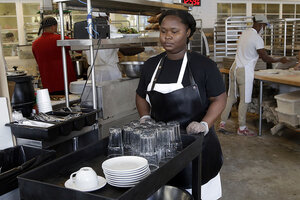As economy hums, fewer workers make minimum wage

An employee pushes a dish cart at Zak the Baker in Miami. On July 6, the US Bureau of Labor Statistics reported that the nation added 213,000 jobs in June. Only 2.3 percent of workers were paid at or below the federal minimum last year, the lowest percentage since 2006.
Lynne Sladk/AP
Manchester, N.H.
It’s “flip flop frenzy” week at the Dollar Tree here on Valley Street, which is celebrating another milestone. Eight months after coming on board, the manager finally has a full complement of workers in place. He has been training the final two associates this week.
Starting pay: $8 an hour – 75 cents above the federal minimum wage.
It’s almost impossible to find anyone in Manchester, N.H., paying the $7.25 minimum. The online service at the local unemployment office lists a dry cleaner offering $8 an hour, an AutoZone delivery driver for $9, and a state toll taker for $13.44. Of the 412 local job listings that include pay information, only one is offering minimum wage – and that turns out to be a mistake.
Why We Wrote This
The US labor market continues to fly high, with a report of 213,000 new jobs in June. We wondered: To what degree is that making the minimum-wage job obsolete?
“Are you sure you’ve got the right place?” asks the assistant manager of a gas station in nearby Hooksett, when a reporter calls. “We start at $10 an hour.”
Here in the comeback mill city of Manchester and in vibrant cities all across the country, the federal minimum wage is affecting fewer and fewer workers. It’s a signal that a strong economy, after years of benefiting upper-income Americans, has finally started to bring more pay raises to retail clerks and other workers at the bottom rungs of the economic ladder.
On Friday, the US Bureau of Labor Statistics (BLS) reported that the nation added a higher than expected 213,000 jobs in June. The unemployment rate actually edged up to 4.0 percent as available jobs and better pay drew more people from the sidelines, but a generally tight job market is expanding pay and opportunities even in states like New Hampshire that follow the federal minimum.
“We don’t see a ton of minimum-wage situations,” says Rudy Ogden, deputy commissioner of labor for New Hampshire. Statewide, there were 15,000 workers paid minimum wage or less in 2016, according to the BLS. A year later, it had fallen by almost half – to 8,000.
Nationally, 29 states and a number of localities have enacted their own higher minimum wages. Only 2.3 percent of workers were paid at or below the federal minimum last year, the lowest percentage since 2006.
Nevertheless, the availability of jobs and pay increases doesn’t provide an automatic escape from poverty for families. Even $9 dollars an hour works out to $18,720 a year, below the poverty line for a family of three. Median pay for fast-food workers nationwide is $8.28 an hour, according to PayScale, an online compensation data service.
Add in the high cost of living in many coastal cities, and the recent boosts in pay are seen by many as a work-in-progress. In the new government jobs report, year-over-year nominal wage growth is 2.7 percent nationwide as of June, a solid but not stellar pace.
Surprisingly, far more workers are paid below the minimum wage than at the minimum wage. They fall into special categories, such as waitresses who get more than $30 a month in tips, teenagers in training positions, or farm workers.
Pay depends on age, of course, so younger and less-skilled workers are more likely to make minimum wage than their older colleagues. It also depends on the industry. Fast-food restaurants, in particular, tend to pay low wages. And these days, location is crucial.
So in Manchester, whose long three- and five-story mill buildings along both sides of the Merrimack River have been converted to lofts, retail space, and a burgeoning set of medical high-tech enterprises, entry-level pay is rising. That’s the case along much of the Washington-Boston corridor as well as on the West Coast.
A Chick-fil-A restaurant in Sacramento drew wide attention in May when it raised starting pay to $17 an hour.
“The economics of fast food … generally doesn’t allow for that,” says David Henkes, a senior principal with Technomic, an international food-service consulting group based in Chicago. “Margins are tight for restaurant operators across the board. It’s not as though there’s extra margin for them to offer $14, $15, $16 an hour.”
That’s especially true in areas that have not boomed so dramatically. Kentucky, for example, has three times the population of New Hampshire but more than six times the number of workers making at or below the minimum wage.
Friday’s employment report suggests that wage pressures will continue to lift workers’ pay above minimum-wage levels.
South of Manchester, at the turnpike toll station, cars are lined up waiting for the single manned booth to take their cash.
More evidence of a worker shortage? The attendant stops to think about it, as more cars join the line. “Two no-shows and someone is running late,” he says.
That $13.44 per hour toll-taking job can’t be filled soon enough.

